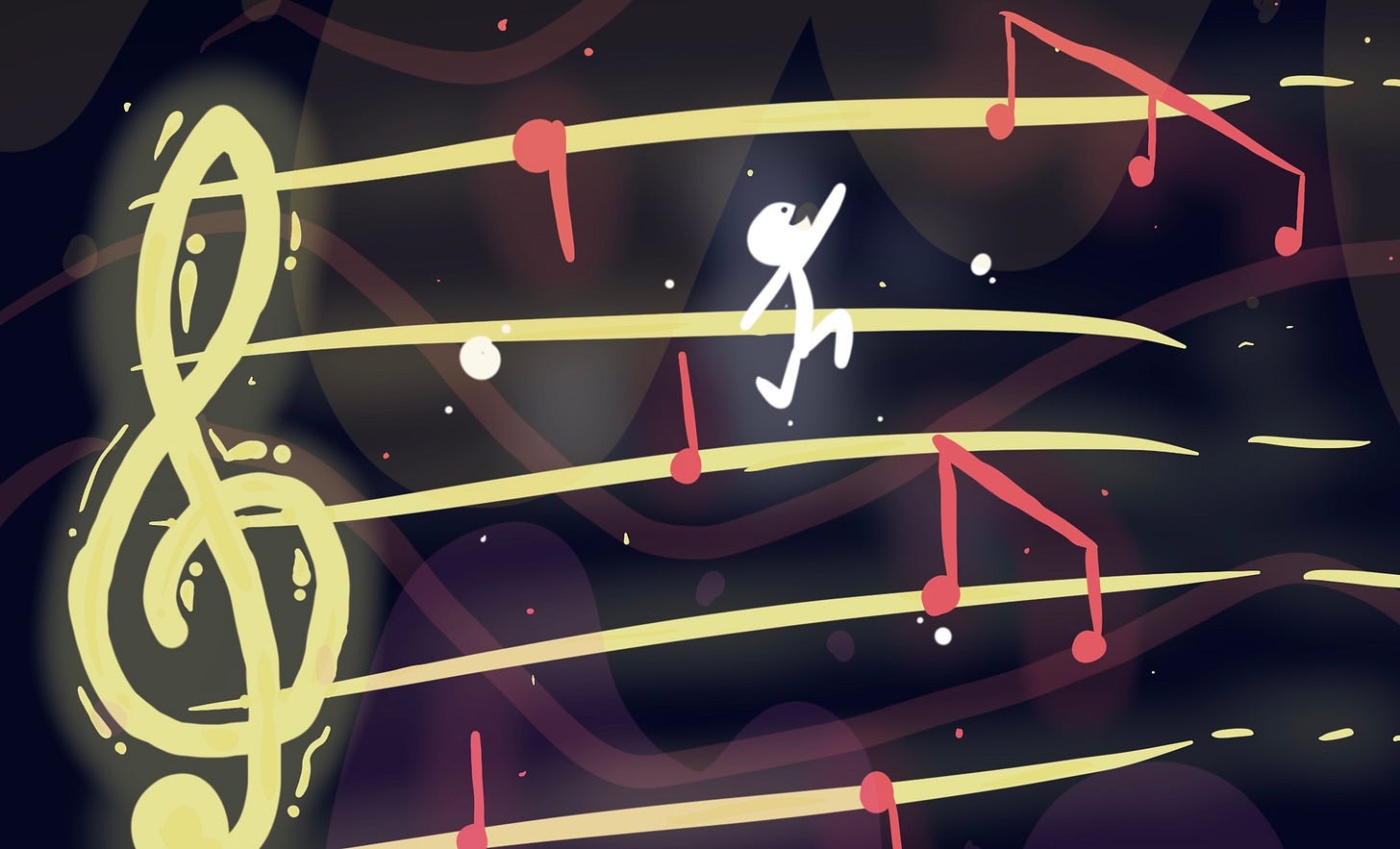On Appearance Emotionalism
What makes sad music sad?
David Bowie’s “Sound and Vision” has a baseline that wiggles and leaps with uncontained joy. It’s a happy piece of music. Of course—the refrain goes—“happy” here cannot mean what it means in “Jones is a happy guy,” or “Jones is feeling happy right now.” But it is not unusual for a word’s meaning to spread beyond its basic use, and indeed with emotion adjectives like “happy” such spreading is attested. We say that someone is wearing a happy expression on their face, or that their crumpled posture makes for a sad slouch. Here “happy” has been spread to an effect: a happy expression is one characteristic of people who are feeling happy. More carefully, a happy expression is an expression which is a natural one for someone showing their happiness in their face to wear. The analysis of sad slouch is similar: it’s a slouch that is a natural one for someone showing their sadness in their posture to pose in.
A theory of emotions-in-music is an attempt to analyze phrases like “happy piece of music” or “sad melody,” and Appearance Emotionalism is the simplest such theory one could assemble from the observations above. Focus for now on melodies, which “move through musical space,” maybe ascending step-wise from C to G, maybe leaping down from G to B. A happy melody, then, is one that moves in a way that is a natural way for someone showing their happiness in their behavior to move. There are, similarly, natural ways to show your sadness, or anger, and so on, in the way you move; and a melody that moves in one of those ways will be, thereby, a sad or an angry melody.
Variation 1 of Bach’s Goldberg Variations, especially in Glenn Gould’s 1956 recording, is joyful, exuberant. Appearance Emotionalism says that’s because it moves in a way a person full of joy would move, if they showed their joy in their motion. I’ve always found this explanation convincing. In the first half the melody runs, climbs, leaps and zig-zags effortlessly before racing home.
Back up: I said that the use of “happy” in “happy expression on their face” was a case of spreading a word’s meaning to an effect. That’s misleading. I can wear a happy face without its being an effect of my feeling happy, and not every face that is an effect of my happiness, is a happy face. My happiness might cause me to frown, if I am trying to hide it; and, as everyone who lives among humans knows, one can put on a happy face even when all inside is darkness and turmoil.
Nevertheless, if understood in a looser sense, it is true that happy expressions are caused by happy feelings. This is evident in the definition given above of happy expression as expression which is a natural one for someone showing their happiness in their face to wear. If someone is wearing such an expression because they are showing their happiness in their face, then, in that case, the expression is caused by their happiness.
The philosopher Alan Tormey, in a book on expression, wrote that “there is a surface to expressive behavior that may become detached. The child who pretends, the actor who portrays, the mime who imitates, and the hypocrite who feigns, all attempt, in different ways, to strip the surface of expressive behavior from the character it normally reveals.” Emotion adjectives can be used to describe those surfaces, even when they have become detached from the inner feelings that, in normal cases, cause them.
Could Appearance Emotionalism be right? One might worry about idiosyncratic modes of expression. Maybe I belong to a community that carefully trains its members to show their happiness in a very slow step-step-skip gait. To us, walking that way when happy is second-nature; it requires no thought or deliberation. The first time you see it you are baffled, but after living among us for a few years you “see happiness” in this walk just as much as you ever saw it in a smile.
Does Appearance Emotionalism then have to say that a melody that moves through musical space in that same step-step-skip motion is a happy melody? Nope. A happy melody, the theory says, must share a natural way for showing happiness. “Natural” here means “built in to human nature.” Learned means of showing are, therefore, excluded.
A harder objection is that no melody in fact moves in a way in which a human can move. Play “Twinkle Twinkle Little Star” in your head. Whatever exactly “motion through musical space” is, the episode of it you just imagined is very different from any way any person has ever moved their body through space. If that’s right, then in particular no melody moves in a way that is a natural way for someone showing an emotion in their behavior to move. But then Appearance Emotionalism entails that no piece of music is happy, the wrong result.
The theory may be saved by a distinction: the distinction between more and less precise ways of doing something. If I raise my hand, I do so in some perfectly precise way: at a rate, for example, of 4 inches per second. You might raise your hand, and do so a tiny bit faster. We do not, therefore, raise our hands in precisely the same way. But ways can be less precise, and there is certainly a less precise way of raising that our hand-raisings share. I raised mine slowly; so did you. So I raised my hand in a way (namely, slowly) that is also a way in which you raised your hand.
Similarly, maybe no human can move in the precise way that the melody of “Twinkle Twinkle” moves. But the melody also moved in some less precise way, which could also be a way in which a human moved their body. For example, “Twinkle Twinkle” begins with a leap; I can also start a motion with a leap.
Stephen Davies, one of the main defenders of Appearance Emotionalism and the man who gave it that name, mentions Saint Bernards.
Saint Bernards have sad faces. This means that the way they wear their face is a natural way for someone (a human being) showing their sadness in their face to wear their face. How can that be? No one ever mistakes a human for a Saint Bernard. The answer (again) is the distinction between more and less precise ways. No human wears their face in the precise way a Saint Bernard does; physiology makes that impossible. But characterized less precisely, there is a way of wearing one’s face (a way that includes, for example, a droopiness to one’s features) that humans—even sad ones—and Saint Bernards can both exemplify.
The fact that no melody moves through musical space in precisely the way any human has or could move through physical space is supposed to be the launch pad for the killer objection to Appearance Emotionalism. In a canonical statement of the opposition, Jerrold Levinson puts it this way:
the appearance of a passage of music is not precisely that of a person, or a person’s face or body in any condition, or a person’s behavior at any moment. [Instead,] when a passage displays an emotion characteristic in its medium of sound sequences, [this is matter of] an appearance similar to that presented by a person in some state.
But:
since everything is similar to everything else to some degree, the issue then becomes one of how similar such an appearance must be to one presented by human behavior in order to constitute an emotion-characteristic-in-sound of the emotion in question.
Levinson then asserts: this question (“how similar must it be?”) is one Appearance Emotionalism cannot answer. The only answer around drives you to an alternative theory. That answer says: a happy melody is one that resembles, in its motion, the behavior of a person expressing their happiness closely enough that listeners are prompted to imagine, of the melody, that it is someone’s expressing their happiness in sonic motion. That is the gotcha moment. Once you say that, Levinson thinks, you might as well drop all the stuff about resembling expressive behavior, and switch to the Hypothetical Persona Theory: a happy melody is one that is to be imagined to be a happy person’s expression of their happiness.
That’s a lot to work through, but we are in luck; the objection fails at the first step. We have said that, when you show your happiness in your smile, your smile may be characterized in more and in less precise ways: as, simply, a smile; as, more precisely, a Duchenne smile; or maximally precisely, so that no one is smiling that way unless you could not tell their face from yours (only your twin could achieve this way of smiling); those are only three of many. The same wealth of ways characterizes anything we do; say, a sad person’s sad gait. Levinson demands, in effect, that we say which of the ways characterizing such a gait are those that make a melody sad, if a melody shares one of them.
The answer is already there, in the theory’s requirement that the shared way be a natural way to show one’s emotions. Recall: a sad melody is one that moves in a way that is a natural way for someone showing their sadness in their behavior to move. For the way you move to show your sadness it must do more than be caused by your sadness. Exactly what more it must do is a subject of debate, but this much seems secure: to show your sadness is to make your sadness public knowledge, so that normal human observers can come to know you are sad by looking at (or listening to) you. But—now the key fact—while every way of characterizing your motion, the precise and the imprecise, may be caused by your sadness, not all of them show your sadness.
If a sad person shows their sadness in the way they walk, probably they are walking slowly. But “slowly” is too imprecise, for it to be true that it is by walking slowly that they show their sadness. What enables people to know that the walker is sad is not their knowing, by observation, that the walker is walking slowly, but their knowing some more specific fact about the way they are walking.
On the other hand, walking in exactly this way, while it may be a way for the walker to show their sadness, is too specific to be a natural way for humans to do it. Everyone’s walk has some idiosyncrasy, something in it which is just them.
Now Appearance Emotionalism can answer Levinson’s question. Let a sad person express their sadness in their walk. Line up the ways of moving that characterize their walk, from the most general (“moving in some way or other”) to the most precise (“walking in exactly this way”). Appearance Emotionalism better not say that a sad melody is one that moves in the first way; that way is too general, every melody moves that way. But it does not say that: for that way is also too general to be a way to show one’s sadness.
Appearance Emotionalism also better not say that a sad melody is one that moves in the last, perfectly precise way; that way is too specific, no melody moves that way. But it does not say that: for that way is also too specific to be a natural way to show one’s sadness.
In the middle is the Goldilocks way, a way (or set of ways) general enough that melodies can instantiate it, yet specific enough that not all of them do, and, in fact, all and only the sad ones do. Those are the ways that are specific enough to be ways to show one’s sadness, yet general enough to be natural ways to do so.
Of course, if you want me to show you exactly where the Goldilocks ways are, you’re out of luck. But this no more refutes Appearance Emotionalism, than my inability to draw the line between red and orange, in the region where they blend together, refutes the hypothesis that red and orange are different colors.




